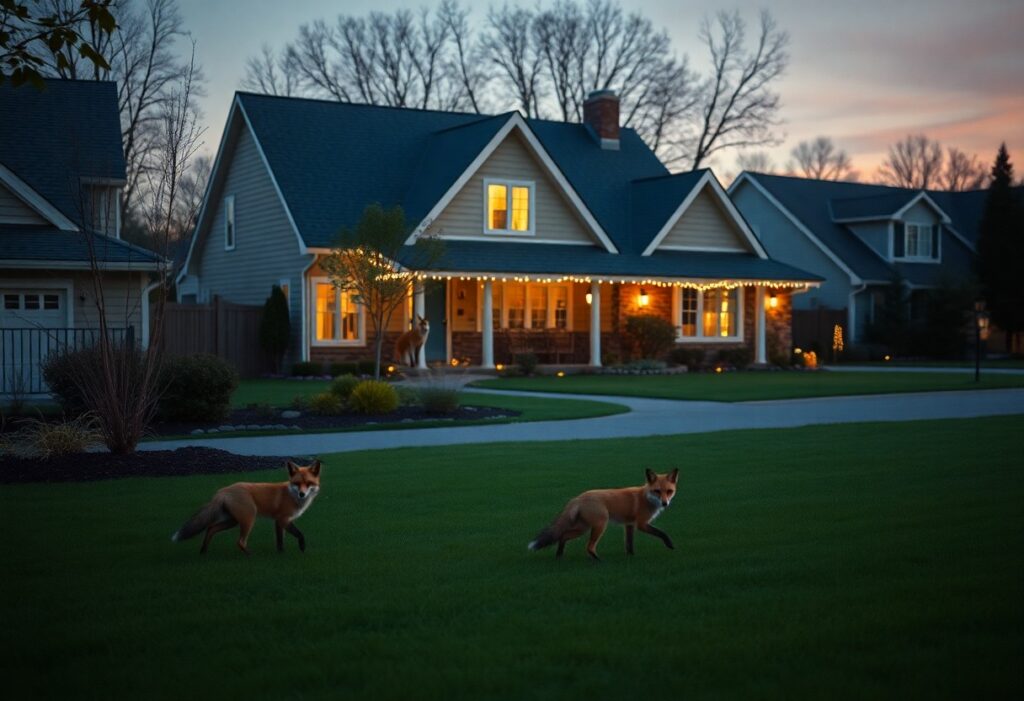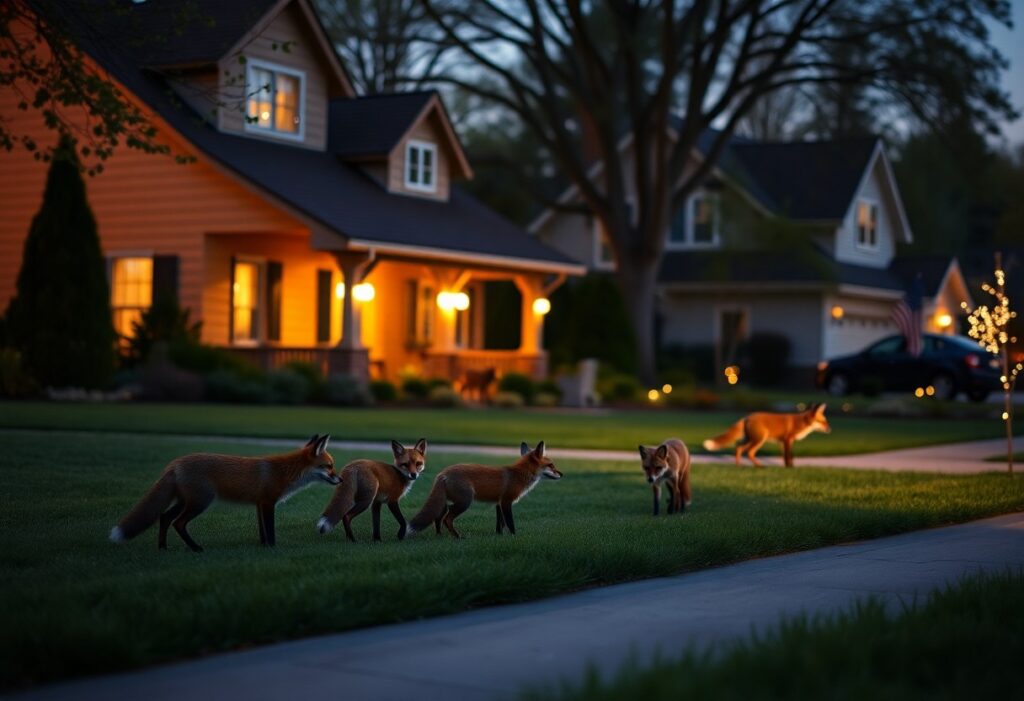There’s a growing trend of foxes in suburbs, making their homes in these suburban neighborhoods, and you might be wondering why that is.
As urbanization continues to push wildlife further into developed areas, these agile creatures have found both refuge and abundant food sources in your backyards.
From changes in land use to the adaptability of foxes, understanding this phenomenon can help you coexist with these fascinating animals and appreciate their role in your local ecosystem.
Key Takeaways to Foxes in Suburbs:
- Urban development provides abundant food sources for foxes, including pet waste, gardens, and small rodents.
- Reduced natural predators and safe habitats in suburban areas contribute to the increasing fox population.
- People’s growing tolerance and interest in wildlife have led to cohabitation between humans and foxes, fostering their presence in neighborhoods.
The Adaptability of Foxes in Suburbs
While foxes are often perceived as wild creatures, their incredible adaptability allows them to thrive in diverse environments.
This resourcefulness enables them to find food and shelter in suburban neighborhoods, often leading to increased sightings.
You may find that their ability to adjust their diet and habits plays a significant role in their growing population in your area.

Urban vs. Rural Habitats
To understand the rising number of foxes in suburban areas, you should consider the differences between urban and rural habitats. Urban areas offer many resources, such as parks, gardens, and even refuse, making them appealing for foxes.
In contrast, rural habitats often have more predators and less human presence, which can limit fox populations.
Behavioral Changes
After adapting to suburban life, foxes exhibit notable behavioral changes that contribute to their survival and expansion in these environments.
You may observe foxes becoming bolder and more active during daylight hours, foraging for food in populated areas, and even adjusting their communication styles to navigate neighborhoods.
With increased encounters with humans, foxes have developed behaviors that help them thrive amidst urban obstacles. These behaviors include scavenging for food near homes, adjusting their breeding patterns, and becoming less skittish around people.
You might notice that foxes are more comfortable exploring your backyard or park, showcasing their remarkable ability to adapt in the ever-changing suburban landscape.
Food Availability for Foxes in Suburbs
Any increase in suburban fox populations can be largely attributed to food availability. As more natural habitats are transformed into residential areas, these animals adapt by finding alternative food sources, including household waste and small urban wildlife.
A study indicated remarkable changes in red fox distribution, highlighting this trend in urban settings.
Urban Food Sources
For urban environments, food sources are abundant, ranging from discarded food in bins to gardens frequented by small mammals and birds.
This easy access to nutrients allows foxes to thrive in suburban areas, which in turn encourages their population growth.
Human Influence on Diet
Around suburban neighborhoods, changes in human behavior play a significant role in the diets of foxes.
As people leave food waste accessible, these animals adapt their foraging habits to take advantage of this newfound abundance.
Consequently, the reliance on human-provided food alters the natural foraging patterns of foxes. By scavenging in parks, streets, and residential areas, they not only expand their feeding grounds but also increase their chances of survival.
This evolution in diet encourages higher reproduction and a thriving population in places previously unsuitable for them, ultimately reshaping the urban wildlife landscape.

Decreased Predation Risks
All across suburban neighborhoods, the number of foxes is rising due to decreased predation risks. With fewer natural predators in these environments, foxes can thrive and establish their territories more freely.
This shift allows them to reproduce more successfully and increases their population density, making them a more common sight in your backyard.
Natural Predators and Fox Populations
The absence of natural predators, such as larger carnivores and humans, has significantly influenced fox populations.
In many suburban areas, animals that once kept fox numbers in check are no longer present, enabling these cunning mammals to adapt and proliferate in your neighborhoods.
Impacts of Urbanization
Beside the reduction in natural predators, urbanization has played a significant role in the rise of fox populations. As cities expand, natural habitats are converted into residential areas, providing foxes with abundant food sources and shelter.
Natural vegetation and landscapes are often replaced by parks and gardens, which can offer plenty of foraging opportunities.
Consequently, food from pet bowls, trash bins, and small rodents thrive in suburban environments, making these areas more attractive to foxes.
Additionally, urban areas provide ample hiding spaces, helping them evade any potential threats. These changes ultimately foster a burgeoning fox population right in your neighborhood.
Climate Change Impacts
Your environment is changing more rapidly than you may realize, and this has significant consequences for wildlife, including foxes.
As temperature fluctuations and altered weather patterns become more prevalent, foxes find themselves adapting to warmer climates and shifting ecosystems.
This climate change influences their breeding patterns, migration routes, and interactions with other species.
Consequently, you may notice an increase in fox populations in suburban areas as they seek new habitats that provide suitable conditions for survival and reproduction.
Effects on Habitat and Food Sources
Beside altering climate conditions, climate change significantly impacts foxes’ habitats and food sources.
As urban areas expand and the environment shifts, foxes are forced to adapt to find food and shelter.
These adaptations often lead them to suburban neighborhoods where food is more accessible, thanks to human activities that inadvertently provide easy meals. As their natural habitats become less reliable, you may find more foxes thriving in residential areas.
Increasing Range of Fox Species
An increasing range of fox species is another consequence of climate change that you should consider. As temperatures rise, certain fox species are expanding their geographic ranges in search of favorable conditions.
This expansion leads to encounters between different fox populations and increases their presence in suburban neighborhoods.
This trend is particularly noticeable with species like the red fox, which has adapted well to urban life and is becoming more common in areas where they were previously scarce.
Sources indicate that as the climate warms, foxes are not only expanding their range but also diversifying.
Different populations are now overlapping in regions where they may not have lived side by side before.
As foxes adapt to new environments, they may also compete for resources and exhibit changes in behavior. This increased diversity in fox species can lead to more interactions with humans, presenting both opportunities and challenges in suburban ecosystems.
Human Attitudes Towards Foxes
To understand the increasing presence of foxes in suburban neighborhoods, it’s necessary to consider human attitudes towards these animals.
While some individuals may view foxes as pests that disturb local wildlife or gardens, others appreciate their beauty and the ecological role they play.
Your approach to foxes can impact how they are received in your community and shape the response towards their growing population.
Perceptions and Acceptance
After years of storytelling and folkloric accounts, societal perceptions of foxes have shifted. Many people now see them as fascinating creatures rather than mere nuisances.
This change often leads to more acceptance and encourages greater coexistence, allowing you to appreciate the wildlife around you while fostering a balanced ecosystem in your neighborhood.
Role of Community Initiatives
With community initiatives focusing on wildlife education, your neighborhood can develop a more harmonious relationship with local fox populations.
These programs often include workshops, awareness campaigns, and access to resources that inform you about living alongside foxes.
Improved knowledge leads to better management strategies and creates a more informed community that embraces the presence of these animals.
Human engagement is vital in shaping community responses to wildlife like foxes. Education initiatives empower you to understand the ecological significance of foxes and reduce conflicts that may arise.
Participating in local conservation projects and attending wildlife workshops can encourage positive interactions, promoting coexistence. By fostering a supportive environment, you can help create a neighborhood that values biodiversity and wildlife, allowing foxes and humans to thrive side by side.
Case Studies
For a better understanding of the fox population dynamics in suburban neighborhoods, consider the following case studies:
- Chicago, Illinois: Fox sightings increased by 36% from 2015 to 2020, with 5.3 foxes per square mile reported in the 2021 survey.
- Los Angeles, California: A study found 25% of urban respondents reported regular fox sightings, marking a 20% increase since 2018.
- Toronto, Canada: Data shows a 50% growth in urban fox populations between 2010 and 2022, with 7.9 foxes per square kilometer identified.
- Seattle, Washington: Research indicated a rise in fox interactions, with 15% of residents noting fox encounters in their neighborhoods within the last year.
Successful Fox Populations in Suburbs
Successful urban fox populations often thrive due to abundant food sources, safe habitats, and minimal human interference.
In neighborhoods with well-kept green spaces and gardens, foxes find easy access to prey, like rodents and birds, allowing their populations to flourish effectively.
This tendency is particularly noted in communities adopting wildlife-friendly landscaping techniques.
Lessons Learned from Urban Fox Management
Among the important lessons learned from urban fox management, collaboration between community members and local wildlife organizations proves beneficial. Creating awareness about fox behaviors and their ecological roles fosters coexistence and reduces conflicts.
Even community outreach programs that educate residents on securing potential food sources, such as pet food and trash, can stabilize local fox populations.
Studies show that areas implementing consistent management techniques experience a decline in negative fox encounters while allowing these animals to thrive in their urban habitats. You can contribute by promoting these practices in your neighborhood for a harmonious coexistence with foxes.
Summing up
Following this, you can understand that the increase of foxes in suburban neighborhoods is influenced by urbanization, availability of food, and improved habitats.
As you adapt to living closer to these creatures, recognizing their behavior will help you coexist peacefully.
FAQ
Q: What are the primary reasons for the increase of fox populations in suburban neighborhoods?
A: The surge in fox populations in suburban areas can be attributed to several factors, including the availability of food sources such as small rodents, birds, and human waste, as well as the reduction of natural predators. Suburbs often provide sheltered environments with gardens and parks where foxes can thrive, and less habitat destruction compared to urban centers.
Q: How do urban developments impact fox behavior?
A: Urban developments have led to the alteration of natural habitats, but they have also created new niches for foxes. As neighborhoods expand, foxes adapt to human environments, learning to navigate streets and utilize yards for denning and hunting. This adaptability allows them to coexist with humans more effectively than many other wildlife species.
Q: Are there any specific seasons when foxes are more likely to be seen in suburban areas?
A: Foxes are often more visible in suburban neighborhoods during spring and early summer as they seek food for their kits (young foxes) and establish territories. During the winter months, they may be less noticeable as they tend to avoid areas with high human activity, but their presence remains in search of food and shelter.
Q: Can suburban areas create environments that are more hospitable to foxes?
A: Yes, elements such as gardens, landscaping with dense shrubs, and the presence of pet food left outside can create inviting habitats for foxes. Additionally, suburban parks with open fields provide ample space for hunting small animals. These environments help foxes to settle and reproduce more successfully in suburban areas.
Q: What are some human actions that can positively or negatively impact fox populations?
A: Human actions such as maintaining clean feeding environments (e.g., securing trash cans) can discourage foxes from taking advantage of easy food sources, which can help maintain a balanced ecosystem. Conversely, actions like habitat destruction through new construction can lead to displacement of fox populations, forcing them to seek refuge in neighborhoods, increasing their visibility and interactions with humans.


